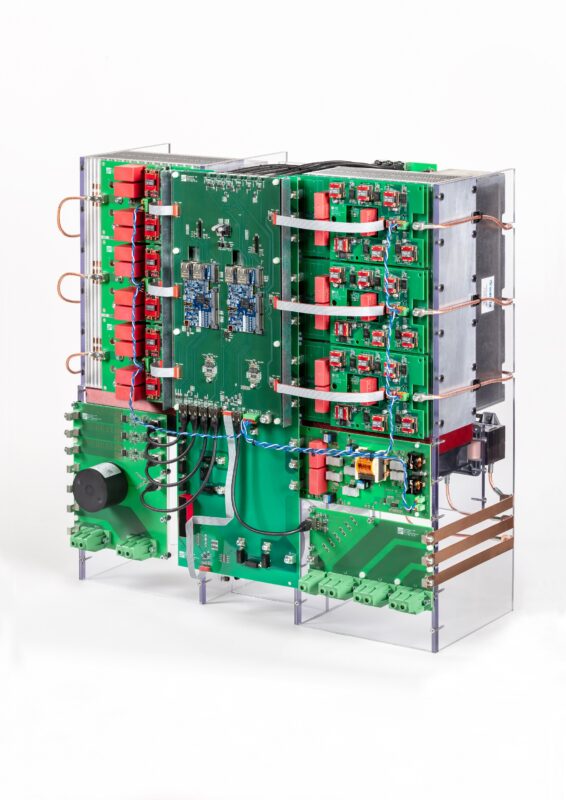In an effort to lower demand for raw materials amid the continued expansion of photovoltaics, the Fraunhofer Institute for Solar Energy Systems ISE is looking at a promising approach to move from the low to the medium-voltage level in PV power plants.
Working with industry partners, the institute is planning its first pilot power plants with this technology and aiming for a broad market launch. To kick-off its new field of research, “Medium Voltage – A Resource-Efficient Way to Interconnect,” Fraunhofer ISE will be presenting the world's first medium-voltage PV string inverter and a medium-voltage battery inverter at the Smarter E trade fair in Munich (June 19-21).

Fraunhofer ISE
Around 73 TW of PV capacity alone must be additionally installed worldwide by 2050, the institute notes. “This will lead to an increasingly large demand for raw materials: According to the International Energy Agency's ‘Global Critical Minerals Outlook 2024,' copper demand will exceed the announced supply from 2025 on.”
“Increasing the voltage of the system can help lessen this demand, since the corresponding decrease in the system’s current can lead to considerable savings in raw materials,” explains Andreas Hensel, group manager for High Power Electronics and System Technology at Fraunhofer ISE.
For instance, increasing the output voltage from 800 VAC to 1,500 VAC results in 75% savings in the cable cross-section with the same power. It is also generally easier to lay and connect smaller cable cross-sections, thereby reducing the installation costs. “Now that PV module costs have fallen by 90% since 2010 due to technological progress and economies of scale, installation and balance-of-system components have become the biggest levers for savings,” Hensel adds.
“The step from low to medium voltage can also increase the power output of the subsystems: At an output voltage of 1,500 V, 10 to 12 MVA are already possible in one transformer instead of the 3 to 5 MVA per transformer that are still common today,” Fraunhofer ISE notes. “Thus, less transformers and switchgear are needed for power plants with medium voltage interconnections. This reduces both the construction and installation costs.”
The move to medium voltage was made possible by the development of high-voltage silicon carbide (SiC) components with high switching speeds. SiC components up to 3.3 kV are now available on the market.
Fraunhofer ISE last year developed the world's first medium-voltage photovoltaic (MS-PV) string inverter as part of its MS-LeiKra project and successfully put it into operation on the grid. The two-stage inverter has an output voltage of 1,500 VAC at a power of 250 kVA.
“We have demonstrated that the technological course has been set for the transition to medium voltage,” says Christian Schoener, project manager of Medium Voltage at Fraunhofer ISE. “Due to the hugely rising demand for raw materials, we are convinced that the question is no longer whether the medium voltage technology will be introduced, but rather who will be the first players in this promising market.” The institute is currently planning its first PV pilot system based on the MS-PV string inverter.
During an MS-PV workshop in April, a European consortium was formed consisting of representatives from all areas of the large-scale PV sector. The consortium is working on setting down the technological and normative requirements necessary for the leap into medium-voltage technology. “As a powerful consortium that is open to additional participants, we can tackle the existing hurdles together and achieve optimization throughout the entire power plant,” Schöner adds.
“Utility-scale PV power plants are just the beginning: Charging infrastructure, industrial grids, large heat pumps, battery storage systems, electrolyzers and wind turbines are also interesting areas of application for the lower medium-voltage level,” the institute explains. “Higher system voltages enable considerable material, cost and space savings and open up completely new system architectures for renewable hybrid power plants, whose individual components are interconnected via the medium voltage.”
This content is protected by copyright and may not be reused. If you want to cooperate with us and would like to reuse some of our content, please contact: editors@pv-magazine.com.



By submitting this form you agree to pv magazine using your data for the purposes of publishing your comment.
Your personal data will only be disclosed or otherwise transmitted to third parties for the purposes of spam filtering or if this is necessary for technical maintenance of the website. Any other transfer to third parties will not take place unless this is justified on the basis of applicable data protection regulations or if pv magazine is legally obliged to do so.
You may revoke this consent at any time with effect for the future, in which case your personal data will be deleted immediately. Otherwise, your data will be deleted if pv magazine has processed your request or the purpose of data storage is fulfilled.
Further information on data privacy can be found in our Data Protection Policy.